|
This paper describes the design of an ultra-precision xy positioning and scanning stage: the Queensgate NPS-XY-100A. Special emphasis is placed on the design concept and metrological considerations that facilitate sub-nanometer position resolution, very high linearity, low hysteresis, low thermal expansion and parasitic motions. Experimental data illustrate sub-nanometer resolution and demonstrate long term stability of the stage.
Introduction
Requirements for higher precision and stability have led to an increased use of sub-nanometer positioning mechanisms in semiconductor, disk drive, scanning probe microscopy and other research and development areas. Queensgate NanoPositioning products combine piezoelectric actuators with Queensgate NanoSensors® (capacitance sensors) and advanced multi-axis flexure design. These technologies are combined with 20 years experience in electronic and servo-loop design to provide positioning stages with sub-nanometer accuracy, precision and repeatability1,2,3. The NPS-XY-100A is representative of Queensgate’s technology and design ability.
Queensgate NPS-XY-100A Specifications
The Queensgate NPS-XY-100A is a two axis closed loop positioning and scanning stage with an envelope of 100 x 100 x 23 mm with a 40 mm diameter aperture. Constructed wholly from Super Invar, it offers > 120 x 120 µm positioning and scanning range. Position noise is typically 0.3 nm (rms) and linearity error (compensated with a 4th order polynomial in the electronics) is less than 0.01%. Hysteresis and parasitic angular motions are controlled to less than 0.005% and 10 µrad, respectively, over the whole travel range. The first resonant frequency of the stage is > 350 Hz.
Description of The NPS-XY-100A Stage
The NPS-XY-100A comprises a proprietary combination of piezo actuators, Queensgate NanoSensors® and flexures. Two piezo actuators are embedded in the stage to provide drive actuation in both axes. Piezo expansion is amplified using a 4:1 flexure/lever design to provide greater than 120 x 120 µm range. The Queensgate NanoSensors® monitor the position of the platform and provide feedback to the controller servo-loop. An extended flexure system guides the motion of the platform in both x and y. The flexure pattern has been specifically designed to minimise parasitic motions such as rotations (yaw, pitch, roll) and out-of-plane motion. To achieve this, extensive FEA modelling techniques were used to optimise the configuration and parameters of the mechanism.
The Queensgate NPS3000 Controller
The NPS-XY-100A stage is driven by the Queensgate NPS3000 controller (a DSP based digital closed-loop control system). The controller has an intrinsic resolution of effectively 23 bits i.e. 12 pm digital resolution over 100 µm range. This performance exceeds the resolution of most A/D and D/A converters currently available and is often below the noise level of most applications we encounter. Advanced digital PID control algorithms can optimise system response for a variety of applications. Velocity feedback (differential term) may be used to damp out mechanical resonances, resulting in significantly reduced settling times. The controller gives the user the tools for complete control of the system bandwidth and loop parameters for in situ performance optimisation.
Metrological Considerations
Non-linearity and hysteresis are error terms along the axis of motion. To assess these static motion errors, the stages are calibrated using a specially designed laser interferometer, capable of resolving motions of 0.05 nm or below 4. Initial scans allow the internal capacitance sensors to be linearised digitally to the fourth order. Non-linearity less than 0.01% is routinely achieved. A plot of linearity and hysteresis errors measured in an NPS-XY-100A is shown in Figure 1.
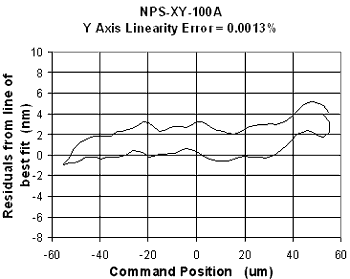
Figure 1. Linearity and hysteresis.
The NanoSensors® and controller are carefully designed to achieve an extremely low noise level down to < 0.005 nm.Hz-½. Combined with 23 bit digital resolution and linearity compensation, true sub-nanometer repeatability is achieved. Figure 2 shows a position signal response of the Photonic Force Microscope (PFM) to a 2 nm diameter circle generated using an NPS-XY-100A stage.
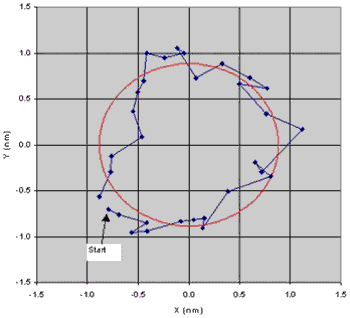
Figure 2. Φ2 nm circle traced by NPS-XY-100A [5].
The Flexure System
The flexure system design guides the stage motion along the desired axis and provides a high 'purity of motion'. Rotation and out-of plane errors are controlled to very low levels without the need for any active compensation. Figure 3 shows the out-of-plane motions measured for an NPS-XY-100A over a 100 x 100 µm scanned area. The out-of-plane motion errors are actually measured to be within a couple of nanometres over the whole scanning range. Again, this measurement includes drift errors. The design allows adjustment of yaw errors which are normally caused by manufacturing tolerances on flexures. Consequently, measured yaw errors down to a few micro-radians over 100 µm range in each axis are achieved.
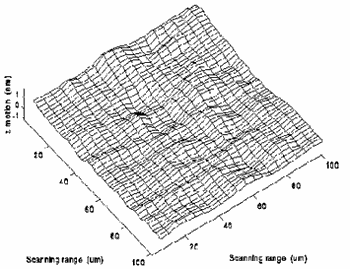
Figure 3. Out-of-plan motion error.
Construction Materials
The NPS-XY-100A is made of Super Invar, this material exhibits extremely low thermal expansion coefficient (about 0.3 x 10-6 K-1) and long term stability. Tests at Queensgate have shown that drift problems may occur if there is a mismatch in the thermal properties of the component materials used in the stage assembly. The NanoSensors® are manufactured from the same or similar materials as stage body, but actuators can not. Piezoelectric material has a very low thermal expansion coefficient (-0.3 to -0.6 x 10-6 K-1). If the stage were built of the more common aluminium, and the length of piezo stack is 40 mm, the difference of thermal expansions generated by these two materials would be about 1.2 µm.K-1 at the piezo end. With the effect of mechanical amplification by a factor of 4, the thermal expansion generates a motion at the platform end of around 4.8 µm.K-1. Although the closed loop control can correct the motion by driving the piezo further, a large HV offset results in a scanning range shift and saturation at one end. Therefore, low thermal expansion material is essential for avoiding thermal effects and all the Queensgate NPS-XY-100A are constructed from Super Invar.
The Frame and Mountings
Frame distortions due to driving forces found in stage the size of the NPS-XY-100A can be at levels up to a few hundreds of nanometres. Special isostatic mounting schemes are designed into the stage to decouple any distortion due to thermal and force changes. This mounting mechanism is again a flexure system, EDM cut into the frame as shown in Figure 4. This regime ensures no conventional contact coupling and friction in the system. The flexure system is compliant in the decoupling direction and very stiff in all other directions, maintaining the centre position of the platform without reducing the stiffness of the stage system. This isostatic mounting mechanism means the stage can be mounted on a base of any material, without concern for thermal matching.
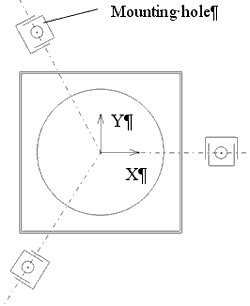
Figure 4. Isostatic mounting.
Dynamic Response and Long Term Stability
The NPS-XY-100A stage has a resonant frequency of 350 Hz and a small signal 2% settling time of <15 ms. Increasing the loaded mass normally has a large impact on the dynamic performance of the system, especially when the stage is such a compact size. The Queensgate digital controllers come with a software tool so that the PID parameters can be easily adjusted by users to optimise the performance in situ. Curve a in Figure 5 is measured from a unloaded stage under the control of optimised PID parameters, curve b shows how the performance was influenced by a 100 g mass loaded onto the stage, and re-optimised PID parameters gives back a desired step response as curve c.
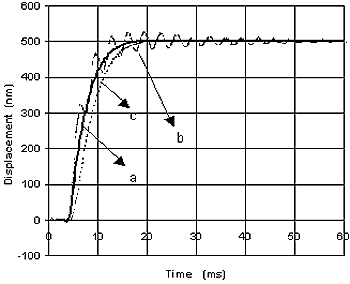
Figure 5. Dynamic response.
A point of interest is the long term stability and repeatability of the NPS-XY-100A. One such stage was shipped to a customer and returned for re-calibration after one and half years. The testing results before and after are listed in Table 1. Note again, these data include the noise and drift errors of the laser interferometer measurement system.
Table 1. Long term stability testing results (NPS-XY-100A, Serial No. 50583).
|
|
|
X-Axis
|
Scale actor error (%)
|
< 0.1
|
0.000
|
0.067
|
|
Linearity error (%)
|
< 0.01
|
0.002
|
0.007
|
|
Hysteresis error (%)
|
< 0.01
|
0.003
|
0.003
|
|
Y-Axis
|
Scale actor error (%)
|
< 0.1
|
0.001
|
0.035
|
|
Linearity error (%)
|
< 0.01
|
0.002
|
0.003
|
|
Hysteresis error (%)
|
< 0.01
|
0.004
|
0.005
|
Conclusions
Conclusions from the design review and test data presented above are as follows;
a. The NPS-XY-100A has achieved the requirement of sub-nanometer repeatability, resolution, accuracy and long term stability.
b. Low thermal expansion materials like Super Invar are essential for building sub-nanometre precision stage mechanisms to avoid the influence of thermal expansion.
c. Advanced digital control allows in situ performance optimisation and improves the dynamic performance of the system.
d. Isostatic mounting decouples inevitable frame distortions from thermal and force effects and maintains the metrological accuracy.
References
- Ying Xu, Paul D Atherton, Thomas R. Hicks and Malachy McConnell, Design and Characterisation of Nanometer Precision Mechanisms (Paper I), Proceedings of ASPE 1996 Annual Meeting, Monterey.
- Ying Xu, Paul D Atherton, Thomas R. Hicks and Malachy McConnell, Design and Characterisation of Nanometer Precision Mechanisms (Paper II), Proceedings of ASPE 1997 Annual Meeting, Norfolk.
- Thomas R. Hicks, Paul D Atherton, Ying Xu, and Malachy McConnell, The NanoPositioning Book, Queensgate Instruments Ltd, 1997
- M.J., Rowley, W.R.C., Precision Engineering (1993) 15, 1
- Courtesy Ernst-Ludwig Florin, European Molecular Biology Lab, Heidelberg
|